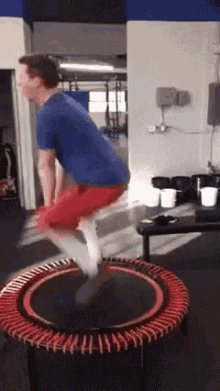Study: Rebound Exercise is the most Efficient Form of Exercise yet Devised by Man


In a 1980 NASA study, scientists found that rebound exercise was the greatest form of exercise for rehabilitating astronauts after spending time in weightless environments like outer space.
TABLE OF CONTENTS
Weightlessness Weakens Bones and Muscles
The phenomenon that keeps us stuck to the ground here on earth is usually explained by the theory of gravity, but it's just a theory. Other people claim that it's simply the density of our bodies being heavier than air that makes us stick to the Earth beneath our feat. Whatever the case may be, without that force pinning us down to the concrete, soil, turf or whatever surface we happen to be standing on, the density of our bones and muscles take it upon themselves to readjust and they end up adapting in ways that are detrimental to our physical health, by becoming weaker.
Strong bones are not necessary in a zero gravity environment, so the bone cells (called osteocytes) are converted to osteoclasts and begin to dissolve minerals from the bones. Conversely, when bones are stressed with any kind of exercise that applies stress to them, bone cells do the opposite and absorb minerals and deposit them into bones.
NASA astronauts can lose as much as 14% of their muscle mass in just fifteen days of space flight. In zero gravity studies on animals with higher metablisms, the deconditioning and muscle loss has been found to be as high as 40% in that same 15 day period of time. Spending time in weightless environments also leads to osteoporotic bone loss, the same as the aged or the bedridden. NASA was looking for a non-traumatic form of exercise that would help to recondition a deconditioned astronaut. For the study they compared running on a treadmill vs jumping on a trampoline, also known as rebounding, and their results may surprise you.
Machines & Exercises At Gyms Are Incomplete and Lacking
Visit your local gym, health club, or athletic department at a local college or university and have a look at all the machines that are there. Most of them are designed to exercise only a very specific set of muscles in the body. This type of isolated exercise is impractical and unnatural, since there aren't many practical ways outside the gym in which we use just a single set of muscles. And therefore, in the gym it's necessary to use many different machines to exercise all your muscles. What if a single exercise could workout every single muscle in your body? You would never have to step foot in a gym again or spend hours trying to apply stress to your muscles.
Try to find an exercise machine in the gym designed to strengthen your entire skeleton and you will find none. Yes, some exercises will in turn work out your bones, but it's going to take sets on probably at least a dozen different machines to work all or even the majority of the bones in your skeleton.
How about a machine that can exercise the involuntary muscles of your digestive and elimination systems? Or a machine that exercises every brain cell, heart cell, liver cell, kidney cell, thyroid cell, eye cell, and all cells of every other organ in your body simultaneously? You won't find a machine like this because it does not exist.
A machine that could help you exercise all muscles, bones, organs and every cell of the body simultaneously would undoubtedly be considered one of the greatest breakthroughs in exercise technology in the entire history of mankind, and the inventor would probably be awarded with a Nobel Prize. It was what NASA was looking for in their study. They wanted to find an exercise that would strengthen the whole body all at once, and they found it, with rebound exercise.
Rebounding Exercises Every Muscle and Bone In Your Body Simultaneously
No exercise in existence even comes close to rebound exercise. Step onto a trampoline and jump, and every muscle, bone, organ and cell in your body are being exercised simultaneously. Even the best exercises in gyms are still inferior to rebound exercise.
To be fair, free weights are far superior to machines in most cases and exercises like squats and deadlifts will exercise the majority of your muscles and bones, but even these exercises can't hold a candle to rebound exercise, and here's why:
When you begin to jump, every single cell in your body is being exercised simultaneously.
While deadlifts and squats may exercise most bones and muscles in your body, they don't exercise the bones of your skull for example, or the muscles of your eyebrow or digestive system.
Jump on a rebounder and not a single cell in your body can avoid the G-forces bearing down on it by the gravitational pull. During rebound exercise, all of the following is being exercised at once:
- Every muscle
- Every bone
- Every organ; brain, heart, skin, eyes, etc.
- Indeed, every single one of your 70 trillion cells are being exercised at the same time.
This is why NASA has been quoted as saying that "Rebound Exercise is the most efficient, effective form of exercise yet devised by man."
5 Fascinating Results from the NASA Study on Rebounding
Some of the results from the NASA study on rebound exercise include:
1. While running on a treadmill, the G-force measured at the ankle was always more than twice the G-force measured on the back and forehead.
This helps to explain shin splints and knee problems, especially when the natural shock absorbing system of the body becomes so fatigued that it doesn't do its job correctly, thus throwing added unexpected forces on already tired muscles, ligaments and tendons, forcing them beyond the point of rupture.
2. While jumping on a trampoline, the G-force was virtually the exact same at all three points, (ankle, back, forehead) and well below the rupture threshold of a normal healthy individual.
This makes it possible to exercise the entire body knowing that there is no undue pressure applied to part of the body such as the feet, ankles, and legs, and at the same time knowing that each part of the body is receiving the necessary environmental stresses it needs to become stronger cell by cell.
3. The external work output at equivalent levels of oxygen uptake were significantly greater while trampolining than running. The greatest difference was about 68%.
The efficient use of the vertical forces of acceleration and deceleration to produce internal loading by directly opposing the gravitational pull develops more bio mechanical work with less energy expended, thus less oxygen used and less demand placed on the heart.
4. While trampolining, as long as the G-force remained below 4G's, the ratio of oxygen consumption compared to bio mechanical conditioning was sometimes more than twice as efficient as treadmill running.
It is important to note that although this experiment was performed on a trampoline where the participants were able to develop a G-force as high as 8-G's, the efficient use of energy was below 4-G's. People involved in rebound exercise on rebound units have been measured only as high as 3.5-G's, so that any activity on a rebound unit is more efficient than treadmill running at any speed.
5. At 4G's oxygen consumption was the same in running as rebounding " . . there was no significant difference in the oxygen uptake between the two regimens".
Exercising on a trampoline with a force greater than 4-G's was found to be no more efficient in terms of oxygen consumption than running. However, it is still vastly superior in terms of safety in regards to pressure on the lower extremities. While running can lead to injuries, during rebounding, cells are far below their rupture threshold providing a safe way to exercise.
Conclusion
The accepted exercise methods and machines of today are incomplete at best, and certainly not the best way to recondition astronauts after spending time in weightless environments.
NASAs 1980 study found that rebounding was the most efficient form of exercise, far more efficient and safer than running. And of course, it's far more efficient than any machine or free weight exercise that you can do in the gym.
I'm certainly not saying to stop doing squats, deadlifts, or whatever else you like to do in the gym. But for those gym rats out there who do enjoy spending time at the gym working hard, it would be beneficial to add some rebounding to your routine, either between sets or in isolation.
And for those who don't currently workout, adding 5-10 minutes of rebound exercise to your daily life is probably the greatest thing you can do for your health, as it is for all those astronauts coming back after floating around weightless inside the cabins of their spaceships for a few weeks with weakened bones and muscles.
If you're interested in purchasing a rebounder, click here to see the one I use and recommend.
References
Abstract
Body acceleration distribution and its relation to the mode of generation were determined in eight young males (19-26 yr) who walked and ran on a treadmill operated at four speeds and jumped on a trampoline at four heights. With increasing treadmill speed, peak acceleration at the ankle (Aa = 3.0-12.0 Gz) always exceeded that at the back and forehead (Ab = 0.9-5.0 Gz, and Ah = 0.8-3.9 Gz); these acceleration profiles included higher frequency components than those during jumping. Corresponding ranges of oxygen uptake (VO2) and heart rate (HR) were 0.8-3.0 l/min and 90-180 beats/min, respectively. With increasing jumping height, acceleration levels were more symmetrically distributed (Aa = 3.0-7.0 Gz, Ab = 3.9-6.0 Gz, and Ah = 3.0-5.6 Gz); VO2 and HR ranges were 1.1-2.5 l/min and 102-175 beats/min, respectively. VO2 was linearly related to HR for both types of exercise. The results indicate that, for similar levels of HR and VO2, the magnitude of the biomechanical stimuli is greater with jumping on a trampoline than with running, a finding that might help identify acceleration parameters needed for the design of remedial procedures to avert deconditioning in persons exposed to weightlessness.
